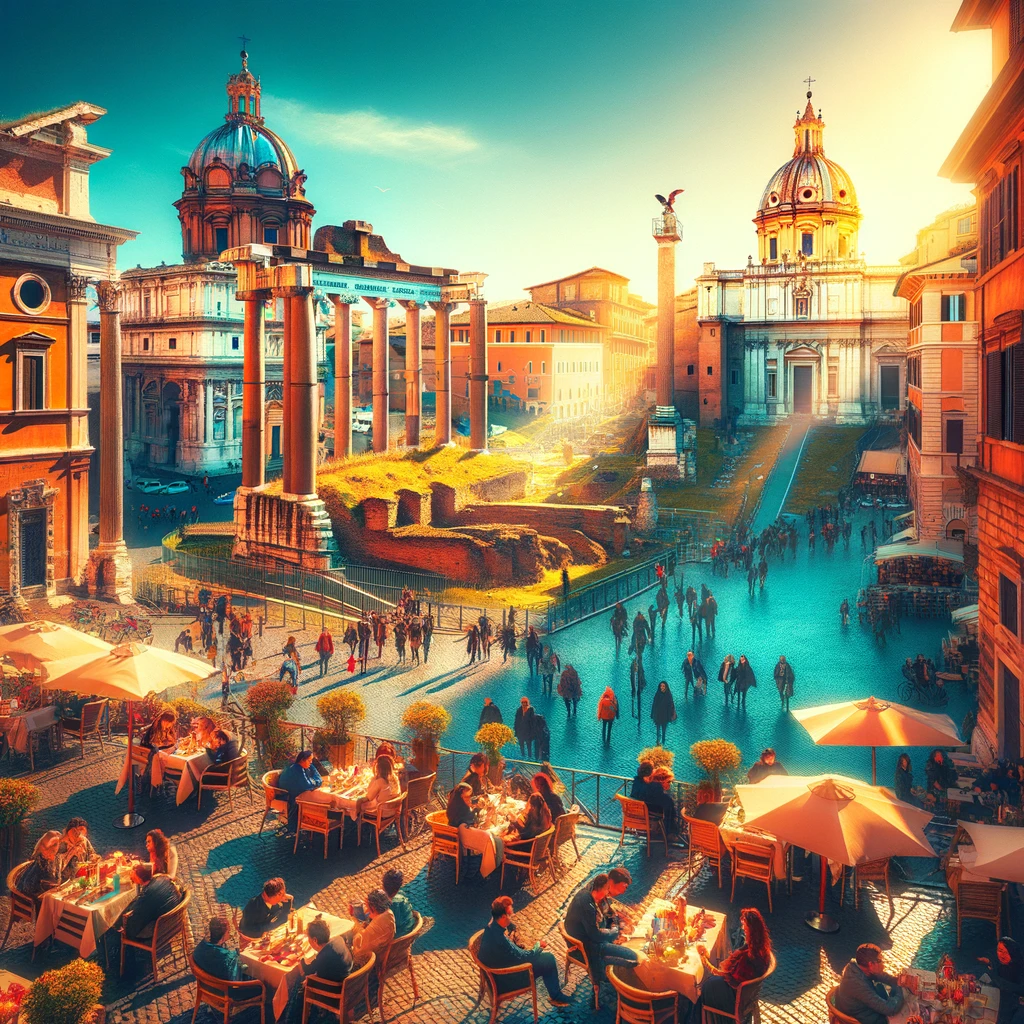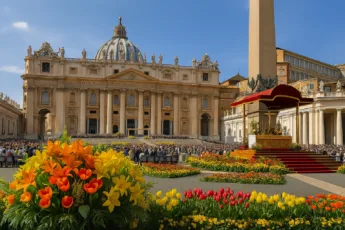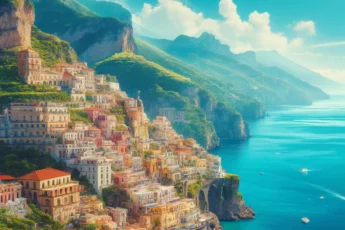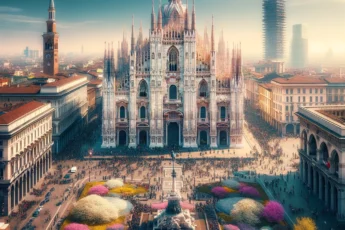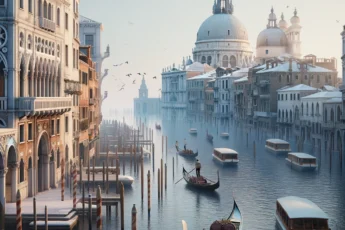Rome comes alive in March, inviting tourists to discover their eternal charms under the warmer rays of the spring sun. This month is a transition from a gentle winter to the full life of spring, which makes it an ideal moment to explore, while avoiding crowds that fill the city at the peak of the tourist season. March brings with it renovated energy, both for the city and its inhabitants, which makes it a special time to experience local culture and history. Rome during this period is full of contrasts - from historic ruins to lush parks that begin to bloom, offering a unique background for anyone who wants to discover its beauty.
Weather and how to pack - detailed information about March weather in Rome and packaging tips
March in Rome is characterized by variable weather, with temperatures ranges from cooler mornings to a pleasantly warm afternoon. Medium temperatures oscillate around 11-17 ° C, which means that a light jacket or sweater will be necessary, especially in the morning and evening. Rainfall is possible, so don't forget to take an umbrella or a waterproof jacket with you. Because the days become longer and the sun is starting to heat more, it is also worth having sunglasses and a headgear. Remember about comfortable footwear, because visiting Rome is associated with a lot of walking on cobbled streets and historic places.
Main tourist attractions - a guide to the necessary places that should be visited in March
March is a great time to explore without crowds of such icons of Rome as the Colosseum, Forum Romanum or Pantheon. Less tourists mean shorter queues, which makes experience more personal and deep. Do not miss the Vatican, including the Basilica of Saint Peter and the Vatican Museums, where you can admire the Sistine chapel without rush. It is also worth visiting Villa Borghese, a vast park offering not only relaxation space, but also Galleria Borghese with its impressive art collections. March is also an ideal time for walks around Tastevere, a picturesque district known from narrow streets and authentic restaurants, where you can experience a local life.
Each of these attractions offers unique impressions that combine the richness of history, culture and art, making Rome in March become an unforgettable place on the map of every traveler.
Events and festivals - a review of March cultural events and festivals that take place in Rome
March in Rome is a time when the city is teeming with life thanks to various cultural events and festivals. This month, Marzanna is celebrated, also called the Spring Day, when residents and tourists can enjoy street parades, live music and colorful food stands. It is also worth checking the calendar of the Teatro Dell'Opra Di Roma events, where opera and ballet premieres are often held. In addition, March is the perfect time to visit the Vatican Museums at night, offering special openings on selected Friday evenings, which is a unique opportunity to admire the art without crowds.
Less known pearls - introduction to less known, but equally fascinating places in Rome
In addition to well -known monuments, Rome offers many hidden treasures that are waiting for the discovery. One of such places is Quartiere Coppedè, a small enclave that impresses with the architectural mix of styles from Baroque to Art Déco. Another place worth visiting is Via Appia Antica, an ancient road that currently serves as a place of walks among the ruins and green landscapes. Montaartini headquarters cannot be missed, where ancient sculptures are designed in contrast to industrial machines at the former power plant. These less known places offer a unique perspective on the history and culture of Rome, allowing you to immerse yourself in its unique heritage.
Culinary discoveries - review of the best seasonal dishes and where to look for them
Roman cuisine, known for its simplicity and taste, in March offers seasonal dishes that are worth trying. Carciof Alla Romana (Roman artichoke) is one of the dishes that reign in the menu of local restaurants during this period. Another seasonal specialty is Abbacchio a Scottadito, delicate lamb ribs, served hot. When visiting Rome, it is necessary to try the caacio e pepe, classic pasta with Pecorino Romano cheese and black pepper. In search of authentic flavors, it is worth going to the trastevere district or on Campo de 'Fiori, where local Trattorie and Osterie offer traditional Roman dishes, enabling deeper immersion in local culinary culture.
Green spaces and parks - where to find peace and nature in the urban jungle of Rome
In the heart of the urban hustle and bustle, Rome offers oasis of peace in its numerous green spaces and parks. Villa Borghese, the largest public park in Rome, is an ideal place for a relaxing walk, a picnic or even a bicycle ride among historic villas, fountains and gardens. For those who are looking for a calmer corner, the Botanical Garden (Orto Botanico) in Trastevere offers an escape to the world of exotic plants and quiet alleys. Another green space that provides breath from the hustle and bustle is the Appia Antica park, where you can walk along ancient Roman roads, surrounded by history and nature. These green spaces are an ideal place for a moment of relaxation and admiring the beauty of natural Rome.
Tips for photographers - the best places and times of day to take photos in Rome in March
Rome offers countless opportunities for photography enthusiasts, and March with its soft light is the perfect time to capture its beauty. The golden hour, both at east and sunset, gives the city a warm, golden glow, ideal for photographing icons such as the Colosseum or Fountain Di Trevi. For those who prefer to avoid crowds, we recommend early mornings when the light is delicate and the streets are empty. The trastevere district with its colorful facades and narrow streets offers a wonderful background for photos full of character. In turn, the view of the city from the Janikulum Hill provides unforgettable panoramas, especially at dawn. By photographing Rome, you can not forget about the details - sculptures, doors, balconies, which together create a unique mosaic of urban landscape.
Shopping in Rome - a guide to the best places for shopping hunting
Rome is a paradise for shopping lovers, offering a wide range of possibilities, from luxurious boutiques to local fairs. Via del Corso and her adjacent streets are the heart of Roman trade, where there are shops of famous brands and small boutiques with unique products. For those who are looking for luxury brands, Via Dei Condotti offers exclusive stores of fashion houses such as Prada, Gucci or Valentino. Vintage lovers and unique finds should go to the porta Portese market, taking place every Sunday, where you can find real gems, from clothing to antiques. For enthusiasts of local products, Campo de 'Fiori offers a daily market where you can buy fresh products, culinary specialties and handicrafts. No matter what you are looking for, Rome will certainly satisfy your shopping desires, offering unforgettable experiences.
Transport tips - as easiest to move around Rome as possible and avoid crowds
Moving around Rome can be easy and pleasant if you know a few basic rules. The metro, although not very extensive, provides quick access to the main tourist attractions such as the Colosseum or the Vatican. Lines A and B cross at Termini station, which makes it easier to change. Buses and trams offer wider coverage of the city, but at rush hour they can be crowded. To avoid crowds, consider renting a bicycle or using electric scooters that are available throughout the city. The Roma Pass tourist card offers not only a free or discount entrance to many attractions, but also unlimited use of public transport, which makes it a profitable option for visitors.
Accommodation - tips on how to find the perfect place to stay, adapted to various budgets
The choice of accommodation in Rome depends on many factors, including budget, location and personal preferences. For people looking for luxury, 5-star hotels around Via Veneto offer elegance and sophistication. Tourists have a more modest budget we recommend accommodation in guesthouses or hostels in the trastevere or esquilino district, where you can experience the authentic atmosphere of Rome at a reasonable price. Apartments for rent are a great option for families or groups of friends, providing more space and freedom. When booking an accommodation, it is worth paying attention to the availability of public transport, which will facilitate the exploration of the city.
When planning a trip to Rome in March, start by establishing priorities - whether you are mainly interested in monuments, culture, culinary or shopping. Then, book air tickets and accommodation in advance to take advantage of the best offers. Consider buying Roma Pass for savings and convenience while sightseeing. Check out the calendar of events and festivals so as not to miss the attractions you are interested in. Remember to plan time to relax in one of the numerous parks or tasting local specialties in charming Roman cafes. Get ready for variable weather, packing the right clothes. With appropriate planning, your visit to Rome in March can become an unforgettable experience, combining a wealth of history, culture and Italian hospitality.
